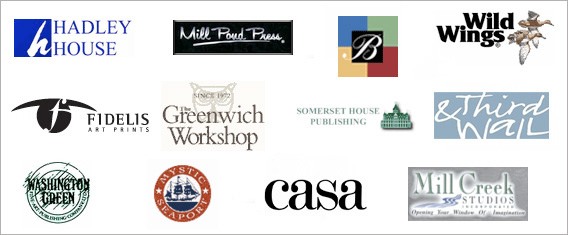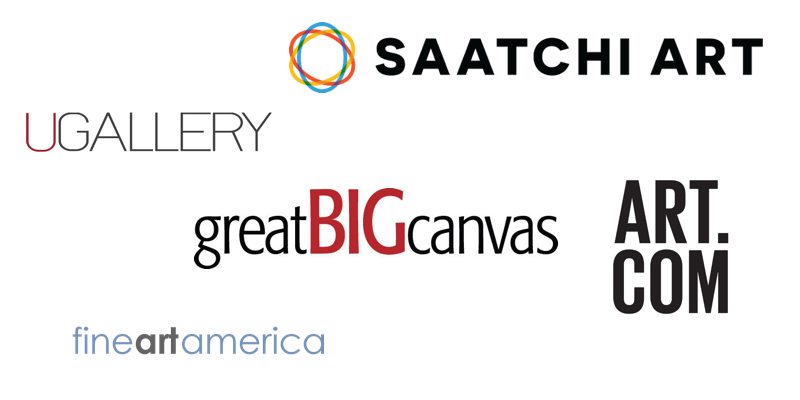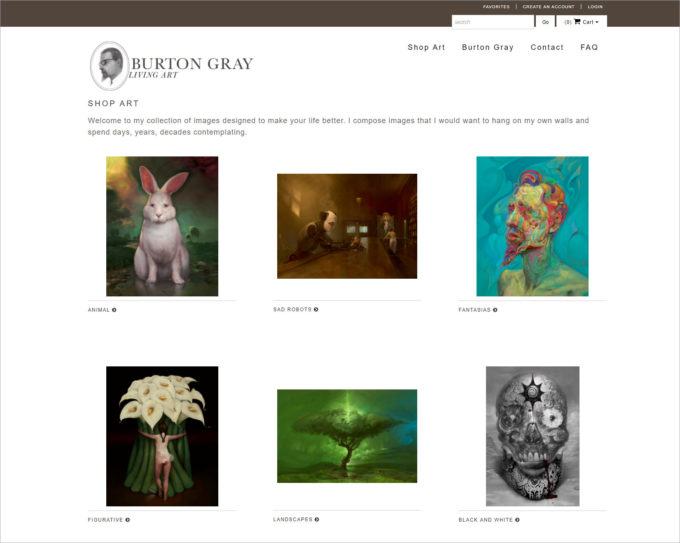[…] our recent post on the 5 Main Options to Sell Your Art, we noted that art fairs provide you with an easy way to get in front of new potential customers […]

The 5 Main Options to Sell Your Art: Pros & Cons
Over the decades and centuries, a lot has stayed the same for artists.
They attempt to produce work that is simultaneously creatively fulfilling and, of course, marketable.
But a lot has changed, too.
The online art market has revolutionized the artist’s reach and given them new ways to fulfill orders in limitless volumes. But what about the art fair? And how do galleries fit in to the current art market?
In this post, let’s take a birds eye view of benefits and drawbacks to the main 5 ways you can sell your art today.
But first: is there a market for your art?
If you are still working towards your first sale, or have only sold to friends and family so far, we highly recommend listening to our podcast episode The “Does My Art Suck?” Test – it’ll give you a good starting point on how to validate that your art is sellable.
Alright, let’s get into the list!
1. Art Fairs
Out on the street in the summer, under a tent, introducing yourself to visitors and telling them your story – art fairs are one of the most enjoyable ways to sell art and meet new collectors.
But how effective are they at actually growing your art business?
Pros
- Easy way to get in front of new potential customers quickly.
- Easiest way to validate that your art will sell to complete strangers (can be done in one day).
- You keep all the profits.
Cons
- Significant time spent with travel, setup + teardown time.
- You need physical inventory to populate your booth, and there are various costs associated with this.
- Limited market size due to the fact that only local clientele can attend.
- Out of the total attendees, a very small percentage will actually be people who share an emotional connection to your work and who will potentially buy.
- Limited sales opportunity (very hard to earn a living).
- Less and less people are attending art fairs — and those who do have less intention of buying art — as a result of the ease of buying art online.
Conclusion: A fun way to build connections and get your art out there for the first time, a good way to validate that you actually have sellable art and to build an initial email list. However, your efforts will often be more time-consuming than financially rewarding, and you’ll rarely find an artist making a decent living on the show circuit.
2. Physical Art Galleries
Traditionally, getting into galleries was almost a rite of passage for the artist. But today, given the way that sales have shifted from offline to online, is it even worth your time?
Pros
- They sell pieces of your art for you.
- They market their gallery and bring targeted buyers in the door.
- If they actually make sales, its easy for you because you barely had to do anything.
Cons
- You share approximately 50% of the sale price with the gallery.
- You rely on someone else (a middle man) to sell your work, and have no control over your destiny.
- Very limited market size — only the local clientele who live in the general vicinity of the gallery, and who care to visit it, will shop there.
- You have to provide the inventory on consignment. Which means you only get paid if and when the piece sells, and they will return it if it does not. Which also means you can’t market and sell the piece directly to anyone else while it is sitting in the gallery.
- Less and less people buy art in galleries due to the proliferation of the online art market. Art galleries have been closing across the country in large numbers for the last 10 years. This trend will only continue as people in their 20’s and 30’s, who do almost all of their shopping online, grow older and become the primary art buyers.
- These days, artists who still rely on art gallery sales are really struggling or have seen steep declines.
- It takes time to visit galleries, to put together and send them your portfolio, follow-up calls and visits, and some salesmanship to try to get them to sell some of your work.
- If a gallery chooses to sell your work, they have limited wall space, and will only show a small portion of your total collection — often times just one piece.
Conclusion: If art galleries are reaching out to you to sell your work, or if you already sell in galleries, by all means you should absolutely continue doing so. Otherwise, if the onus is all on you, there are more profitable ways to spend your time.
3. Art Publishers
Successful art publishers have all the connections you could ever hope to make, right? Let’s break it down:
Pros
- They sell your art for you.
- They have established distribution channels to sell art in retail.
Cons
- Like art galleries, they are another example of the “middle-man” business model that are increasingly going out of business, or have faced steep declines in sales and sales potential, due to the proliferation of the internet.
- They take a very high percentage of each sale, sometimes above 90%.
- They have full control over your artwork. Which means once they license it, you can’t sell it anywhere and are completely reliant on them to earn you income.
- Very low success rate — it is extremely difficult to find an artist in this day and age who is thriving due to their relationship with a publisher. Instead, what you most commonly find is the opposite – artists who “signed their life away” to a publisher and have little to show for it.
Conclusion: These days, building a successful career with a publisher is a needle-in-a-haystack situation. If you do get approached by a publisher, do your research and read the fine print. Make sure you don’t sign your life away.
4. Online Marketplaces / Big Online Art Galleries (Fine Art America, Saatchi Art)
These all-encompassing online art galleries are already established giants and get lots of traffic, and their space (the online art market) is going up, not down like retail galleries.
Pros
- Anyone with a computer and a digital image can participate.
- Easy to upload and get your work for sale.
- They have traffic, and some of this traffic might stumble upon your work and buy it.
Cons
- You share a portion of the sale, which can reach as high as 45% on some websites.
- Very low success rate. If you are in the top 1% of sellers, it means you might sell one piece of art per month.
- Art is sold based on price and how it looks compared to others in the same genre, instead of the emotional connection that the customer has with the artist and the meaning/inspiration behind the artwork.
- The low prices you have to offer in order to stay competitive will make it harder to command higher prices from your art in other venues.
- As soon as you upload a single image to these websites, these companies SEO your name and everything about you and your artwork in order to get all the traffic of people who know you or learn about you through your own efforts. This means someone might learn about you at an art fair, or in an art gallery, but when they search for your name in Google (i.e. John Doe fine art), they end up visiting one of the big art gallery websites and buying from them rather than you directly – they may even get distracted while browsing and end up finding another artist to buy from!
- When you make a sale, you usually do not obtain the customer’s email address (something critical for you to have) or any other direct contact information. Without an email address, you can’t do more advanced tactics like remarketing on Facebook/Instagram in order to turn one-time customers into repeat buyers.
- You may make no sales at all, which may lead you to think that either your art is bad, or unsellable, or that you have no business opportunity. None of this may be true, and it can be a huge blow to your confidence and a push in the wrong direction. It may just be because you are getting no exposure, or that the competition is too heavy, or that your pricing isn’t low enough, or that you are just trying to sell your art in the wrong market.
Conclusion: The online art galleries offer an easy way to get your art in an art gallery with no discretion or roadblocks.
But, you will be competing against tens of thousands of others, and it’s often a race to the bottom to offer a more attractive price than your competition. Only a very low percentage of artists make consistent sales, and an even lower percentage earn enough to pay the bills. Ask around before you join, be careful where you upload your work, and ALWAYS upload your work to your own website before you ever upload to an online gallery in order to protect your name and SEO efforts.
5. Your Own Art Gallery Business, Online
The final (and, in our opinion, the most promising) way you can sell your art in today’s art market is by starting your own online art gallery.
Pros
- Very high upside potential — there are part-time artists and photographers who run their own mini art gallery online as a side business and earn an extra $10,000 – $20,000 each year, and there are also full-time artists who earn over $100,000 each year. This is the only opportunity that allows you to start really small and has the potential to grow into something really big.
- Your success is not dependent on anyone else. You completely control your own destiny, and all of your work stays with you.
- You build your own customer relationships based on their connection to you and your subject matter, rather than attracting people who are comparison shopping based on price.
- No inventory investment needed – you can sell your work on-demand (if you sell prints, you can print-on-demand as you make a sale).
- Unlimited market size – you can sell to anyone, anywhere in the world who shares a connection with you and your work and wants to buy it. There are no geographic limitations, which is part of the reason why the upside potential is so high.
- Your art gallery includes all of your art rather than just a few pieces, and you get to curate it any way you want to!
- It’s very inexpensive to launch, making the barrier to entry very low. Today, anyone can run their own art gallery business online even as a small side project.
- The ongoing costs are extremely low, making it very low risk and low pressure. You can put in whatever effort you feel like, and grow it slowly over time.
- It is a real business that you can retire on, and even pass on to your kids!
Cons
- You have to put in the setup time to upload your images and curate your online art gallery.
- You have to execute on a set of marketing tasks on a monthly basis in order to drive traffic and earn repeat business (the good news is, while this used to be cryptic and difficult — it is now easier than ever to do.)
- It requires a small upfront investment whereas most of the other options do not.
Conclusion: Launching your own online art gallery solves the biggest problems of many other ways of selling art. You’re not limited geographically like with an art fair, you’re not giving up control of your work like with retail art galleries, you’re not losing out on most of the profit like with an art publisher, and you’re not competing for lowest price like with marketplaces.
So, what do I do with this information?
If you’ve already sold plenty of your art, and any of the above methods are actually working for you – you should absolutely continue doing them.
If you’re new to selling your art, or you haven’t tried some of the above methods — you should carefully consider each of them before diving in.
How can Art Storefronts help?
We believe, based on what we have seen in the market over the past half a decade, that the brightest future for artists comes with running your own online art gallery business in cooperation with any of the other things you are already doing to create success.
We covered what is happening in the industry, and how the artists that have incorporated this way of selling art for the last 5 years have greatly benefited from it, in this article.
If you’re interested in incorporating this way of selling art into your repertoire, we can help.
Sell More Art Online
If we can't teach you, no one can!








